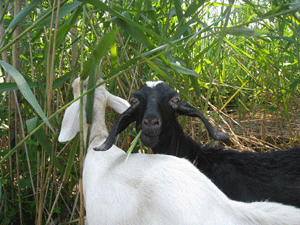07
Oct
Study Shows Goats as Viable Control Agent for Opportunistic Wetland Reeds
(Beyond Pesticides, October 7, 2014) Goat grazing to control opportunistic, unwanted, and poisonous plants has taken off across the country, as researchers continue to find new value in these personable animals. According to a study published last month by an international team of scientists in the journal PeerJ, goats have an outstanding potential to effectively control the opportunistic, or “invasive” reed Phragmites australis, and replace the unnecessary use of costly and dangerous herbicides.
 Although a native species of phragmites exist in the U.S. (phragmites australis subspecies americanus), these plants do not form the dense monotypic stands characteristic of European phragmites (phragmites australis subspecies australis), which was introduced to the U.S. east coast in the early 1800s, and is currently found in wetlands throughout North America. The plant can grow up to 15 feet tall, and has been widely implicated in reducing biodiversity and crowding out native species in wetlands. Land managers throughout the country are encountering phragmites and resorting to the use of toxic and expensive chemicals, usually combinations of the herbicide triclopyr and glyphosate, both of which have shown evidence of harm to aquatic species. A study published in 2013 in the journal Estuaries and Coasts found that between 2005 and 2009 over $4.6 million per year was spent to control phragmites, with 94% of control tactics using herbicides on over 80,000 hectares of land. However, as the study notes, “Despite these high expenditures, few organizations accomplished their management objectives.”
Although a native species of phragmites exist in the U.S. (phragmites australis subspecies americanus), these plants do not form the dense monotypic stands characteristic of European phragmites (phragmites australis subspecies australis), which was introduced to the U.S. east coast in the early 1800s, and is currently found in wetlands throughout North America. The plant can grow up to 15 feet tall, and has been widely implicated in reducing biodiversity and crowding out native species in wetlands. Land managers throughout the country are encountering phragmites and resorting to the use of toxic and expensive chemicals, usually combinations of the herbicide triclopyr and glyphosate, both of which have shown evidence of harm to aquatic species. A study published in 2013 in the journal Estuaries and Coasts found that between 2005 and 2009 over $4.6 million per year was spent to control phragmites, with 94% of control tactics using herbicides on over 80,000 hectares of land. However, as the study notes, “Despite these high expenditures, few organizations accomplished their management objectives.”
A New York Times article also recently questioned the lengths to which land managers have gone in attempts to snuff out the reed. “The Sisyphean task of completely clearing the reed again and again throughout eternity is a level of commitment that seems unrealistic,” wrote author Dave Taft. The piece goes on to realign the plant’s role in ecosystems, noting its value in pollutant filtration, habitat for certain species, and use as a material for pen making. Despite calls to rethink the role of plants now considered “invasive” (as many are also doing with the Southwest’s tamarisk trees), it continues to be viewed as a problem in need of solution.
And there is evidence that removing phragmites increases biodiversity after it is cleared. However, the use of herbicides that have been linked to, for instance, shape changes in frogs and harm to non-target species indicates that the risks are not worth the benefits. As with all pest problems, least-toxic alternatives provide a solution that addresses natural systems, and is more cost effective in the long term. The recent study shows that goats can adequately fill this need.
To study how well goats controlled phragmites, researchers placed two goats together in an enclosed space and left them to consume the reed. Phragmites was then allowed to re-sprout to a height of around 5 feet before the next round of grazing. The grazing impact of the goats was compared to a control space where no changes were made. Results showed that the goats were able to reduce the density of phragmites stands five-fold, from nearly complete phragmites cover to only ~20% phragmites. Although phragmites sprouted from its rhizomes to colonize areas adjacent to the grazed plots, those where goats grazed never attained the same cover and stand density as before the goats arrived. Moreover, plant species and richness increased after goat grazing, up 100% to 400% on the Shannon-Weiner diversity index.
The authors also discovered that cows and horses will willingly eat phragmites. According to an article in TakePart, part of the impetus for the study came from lead author Brian Silliman, Ph.D., who observed cleared stands of phragmites in European marshes where livestock grazed.
Communities across America, including Colorado, Chicago and New York, are employing goats for their unwanted vegetation. In Washington D.C. goats helped replace the outdated herbicide regimen in the Congressional Cemetery. In Northern California, utility Pacific Gas and Electric employed goats to clear brush that presented a fire hazard. Shortly after, the city of Anaheim, CA followed suit, using the goats to help alleviate the danger posed by the state’s drought.
In a variety of landscapes that are unsuited for mechanical controls, goats provide a solution to brush and weed problems. At the 32nd National Pesticide Forum in Portland, OR, Beyond Pesticides Board Member Lani Malmberg, owner of Ewe4ic Ecological Services gave a rousing talk on the benefits of g employing goats to manage land responsibly. Go here to view her talk on YouTube. And for more information about the debate over “invasive” species, see our program page, on Invasive Weed Management.
All unattributed positions and opinions in this piece are those of Beyond Pesticides.
Source: PeerJ, TakePart, New York Times
Photo Source: University of Nebraska










